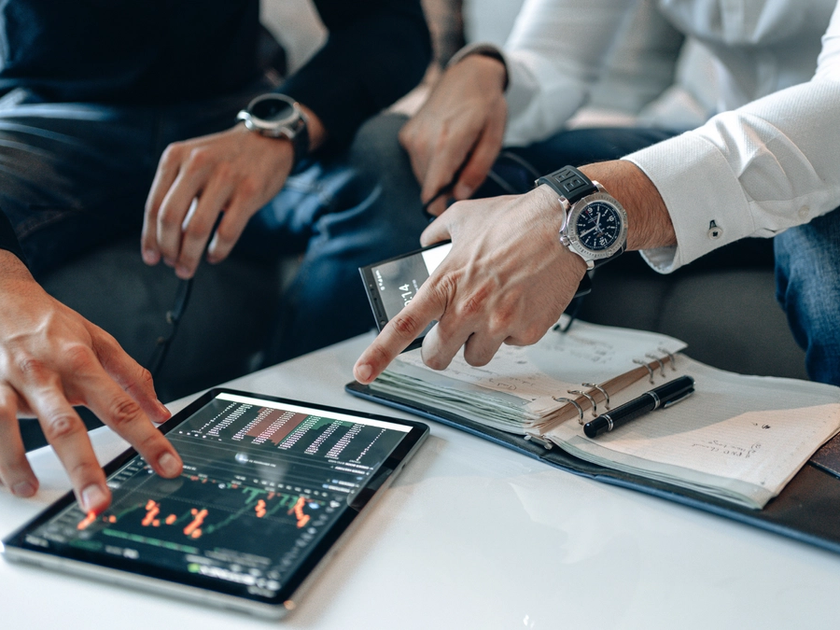What is cryptocurrency?
In short, cryptocurrency is a new type of digital currency. It's a money form that exclusively exists digitally - meaning that there are no physical bills or coins connected to cryptocurrencies.
The special thing about cryptocurrency is that it’s a “decentralised” currency. This means that there are no middlemen when buying and selling goods. So, there are no banks or governments facilitating the trades.
What does that mean?
When you buy and sell goods, you’re using money to represent the value of said goods. A litre of milk could cost 10 DKK. You swipe your card, and the money is transferred to the grocer. But the money does not go directly to the grocer. The money is deposited into the grocer’s account, and this account is facilitated by a bank. In other words, the bank is a type of middleman.
Imagine, if you will, that the money went directly to the grocer instead. That is essentially how cryptocurrencies work.
Read more about investing in cryptocurrency.
Cryptocurrency is also an unregulated market. Among others, this means that there’s no central authority who decides what the price of a coin should be.
‘Regular’ money is controlled by central banks and similar authorities. This puts a cap on how quickly - and how much - the price may rise and fall. With crypto, there are no limits. That’s why the value of cryptocurrencies can rise and fall very rapidly.
You can also read more about why cryptocurrencies rise and fall here.
THE HISTORY BEHIND CRYPTOCURRENCY
The very first cryptocurrency ever developed was bitcoin - that was in 2009. Behind the invention is the anonymous character, Satoshi Nakamoto. It is yet to be known whether Satoshi Nakamoto is a single person or a group of people. The groundbreaking factor of bitcoin is the technology that underlies the currency - blockchain . The actual idea for blockchain was developed earlier, and the first building blocks for the technology were already taking place back in the 80’s.
Satoshi Nakamoto took the idea one step further. By using blockchain technology, he/she/they succeeded in creating the world’s first decentralised currency.
The fact that the currency is decentralised simply means that there’s no central authority - a middleman, such as a bank or authority - to facilitate transactions. When you purchase an item, the money will be deposited directly into the business’s account.
The fundamental idea with cryptocurrency is to create a society, where purchasing and selling goods happens directly between buyers and sellers.
A BIT ABOUT BLOCKCHAIN
Imagine a blockchain as a large registry. All purchases and sales made with cryptocurrencies are registered in this registry - in the blockchain. All transactions are being noted in the registry. But what if someone were to hack into the registry?
The smart thing about blockchain is that all transactions point back to the previous transaction.
Example:
If you purchase something from Sophie with crypto, it will be registered with the code “A”. In the code “A”, a number of details will appear: Sophie’s name, your name, and the price of the thing purchased.
Sophie now uses the money you paid with to purchase a different thing.
This will be registered in the blockchain with the code “B”, where details about the buyer, seller, and price will appear. But there will also be information regarding the previous transaction - so when you look at Sophie’s transaction in the blockchain, you will see code “B”, but also “A”.
And it will keep on doing just that.
The next transaction will contain the codes “B” + “C”. The next transaction will contain the codes “C” + “D”.
In reality, the codes are much more complicated, and are called ‘Transaction hashes’. An example of a transaction hash is:
6146ccf6a66d994f7c363db875e31ca35581450a4bf6d3be6cc9ac79233a69d0.
You can look up transaction hashes on Etherscan.io .
That’s why a blockchain can be pretty complicated to hack.
HARD TO HACK
While blockchain is a digital registry, it’s not stored on a single computer alone. A blockchain is publicly available, so anyone can download it and keep track of whether the codes are correct and are pointing back towards the right transactions. For example, if a person were to hack a blockchain, wanting to change codes “B” + “C” to be called “B” + “X”, where X represents the hacker’s own account - so it then would look like the hacker actually owned that money.
But here, they will encounter yet another safeguard: Because hundreds of other people have a copy of the blockchain, which is updated daily, and will thus not be able to recognise codes “B” + “X”. Because in their registry, it says “B” + “C”.
Before the hacker would even succeed with their theft, it would demand that this person hacks over 50% of the registers in the network. And that exactly is the thing that makes crypto so difficult to hack.
In reality, it’s not just a hundred people who have copies - it’s more likely to be in the thousands.
Those who keep a copy of the blockchain are called “nodes” in crypto-circles. The fact that the blockchain register is distributed among many people is called a “distributed ledger”.
HOW TO GET STARTED TRADING CRYPTO
- 1
Download Lunar for free
Go to App Store or Google Play and download the Lunar app. Find your photo ID, as you need that to sign up.
- 2
Sign up to Lunar Block in the app
Find Lunar Block under “Products” and sign up. You’ll be asked to take a test about crypto first - among others things, it’s to see if you’re aware of the risks. You can learn more about the risks in the app before you take the test.
- 3
Buy cryptocurrency with a single swipe
When we’ve approved you, you can buy crypto immediately. Choose your cryptocurrency in the app and buy with a single swipe.
Last updated April 18, 2023. We’ve collected general information. Please note, that there may be specific circumstances that you and your business need to be aware of.
You might also like...
Where can I pay with solana?
Cryptocurrency is becoming so widespread and acknowledged abroad that you can use the currency just like regular payment methods on some...
How do you buy solana as regular stocks?
Because solana (SOL) is a currency, and not a business, you can’t actually invest directly in solana like it’s a stock.
Are cryptocurrencies a good investment?
Cryptocurrencies can be a great addition to your portfolio - if you’re willing to run the risk. Cryptocurrencies are “high risk - high...
What is bitcoin?
Bitcoin is a digital currency, or cryptocurrency, as it’s also called. Bitcoin is the first and largest cryptocurrency measured on market...


